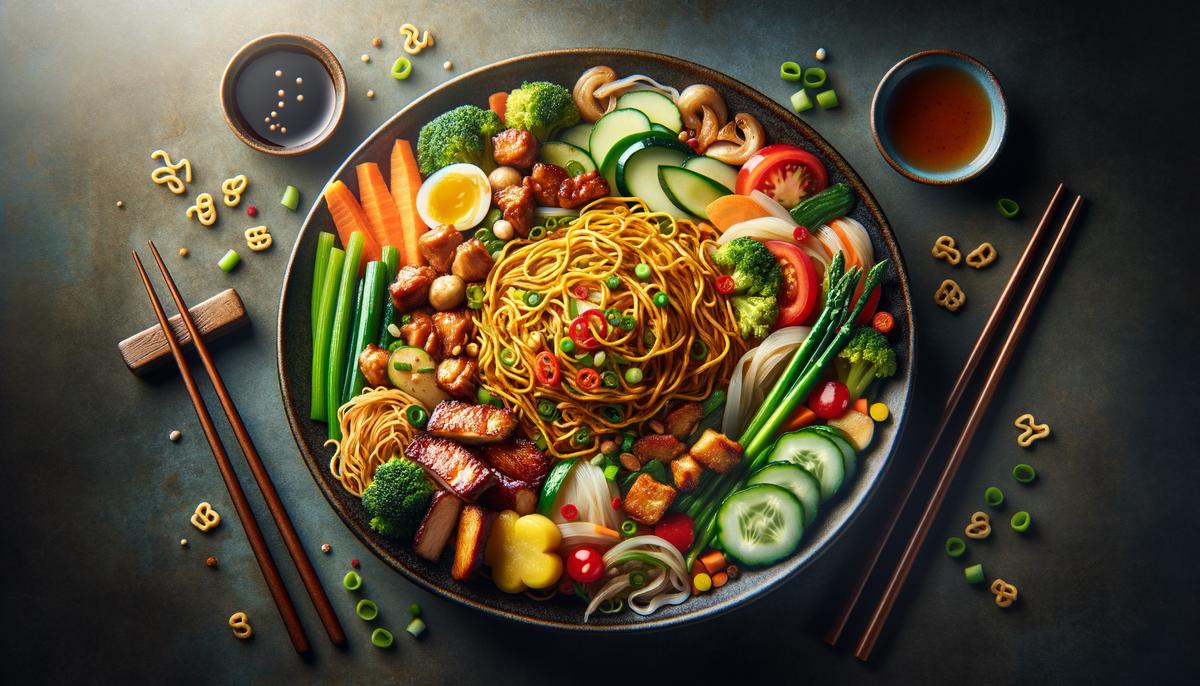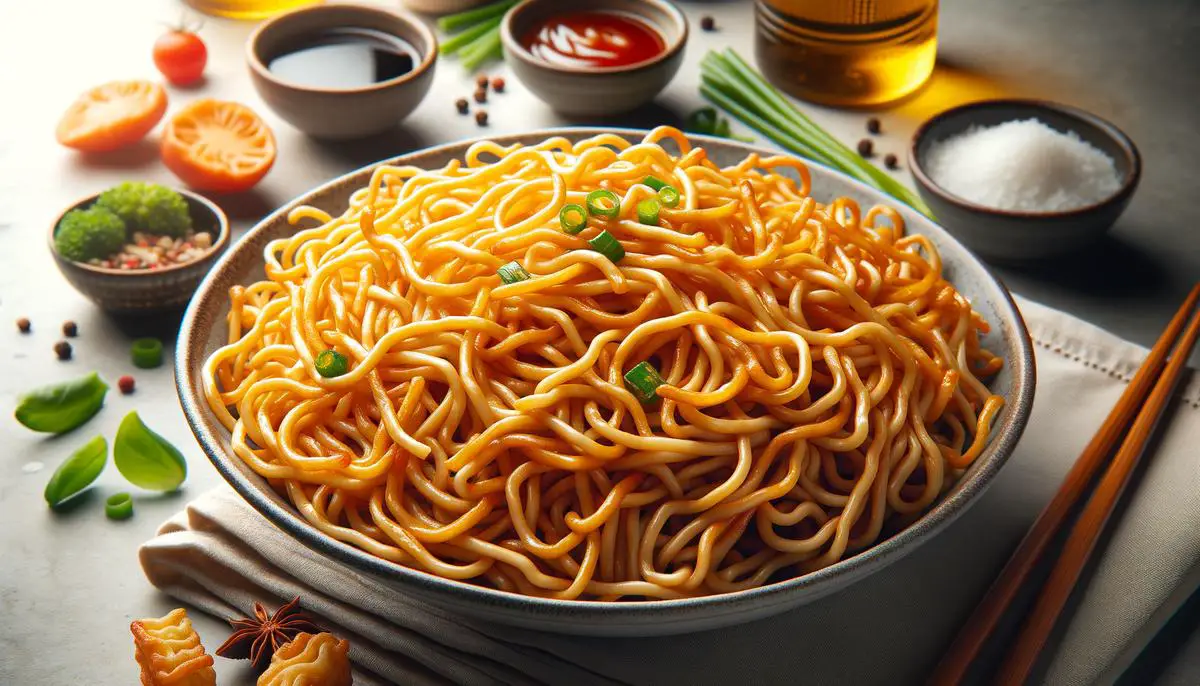Hong Kong Style Chow Mein stands as a testament to the art of balance in cooking, blending simple ingredients into an extraordinary dish. This guide aims to demystify the process, offering clear steps and insights into creating a meal that resonates with tradition and taste. From selecting the right noodles to achieving the perfect stir-fry, each component plays a crucial role in crafting this beloved dish.
Selecting the Right Ingredients
Crafting the Perfect Hong Kong Style Chow Mein: An Essential Guide
In the culinary tapestry of Hong Kong cuisine, Chow Mein holds a place of reverence. Its conception is simple: noodles, vegetables, meat, intertwined in harmony. Yet, attaining perfection in this dish requires precision – each element contributing just the right note to a symphonic blend of flavors and textures. Here’s your guide to mastering the art of Hong Kong Style Chow Mein.
Noodle Nuances: The Foundation
The soul of Chow Mein lies in its noodles – they must be thin, egg noodles, ideally fresh, capable of achieving that quintessential balance between softness and a crisp edge when stir-fried. Boil them alight, then toss them in cold water to halt their cooking journey. A swift, meticulous drying follows, ensuring they are primed for their wok adventure.
Protein Picks: The Substance
Traditionally, Chow Mein sings with the inclusion of thinly sliced beef, chicken, or shrimp. Marinate your choice in soy sauce, a touch of sesame oil, and a sprinkle of cornstarch. This isn’t just about flavor – it’s about texture, too. The cornstarch acts as a velveting agent, ensuring your meat remains succulent amidst the high heat of stir-frying.
Vegetable Variety: The Crunch
Here, diversity is key. Classic companions include bean sprouts, carrots, and cabbage, sliced with precision for quick cooking. Their freshness is non-negotiable, their crunch a crisp counterpoint to the soft noodles and tender meat. Toss them in the wok with a confident hand – they’re not there for a long time, just for a good time.
The Flavor Quartet: Sauce and Seasoning
The condiments constitute the invisible thread tying this culinary masterpiece together. A harmony of soy sauce, oyster sauce, a hint of sugar, and sesame oil, mingled with a dash of chicken stock to unify the dish. The soy provides depth, the oyster sauce complexity, the sugar a whisper of sweetness, and the sesame oil a nutty climax to this symphony of flavors.
Bringing It All Together: The Wok’s Embrace
Ignite your stove, let the wok grow scorching – a heat shy of Dante’s inferno. Start with high-temperature oil, then meat sizzling to perfection – removed just shy of completion. Vegetables next – a rapid dance in the wok before reintroducing the meat. Noodles enter, a quick toss then the pour of our harmonized sauces. A final charade under the wok’s scalding tutelage pulls it all together. Serve immediately – piping hot, imbued with the breath of the wok that is essential to its very essence.
Final Verdict
Perfection in Hong Kong Style Chow Mein is attained not just in the ingredients or the method but in the ballet of balancing flavors and textures. It’s a testament to simplicity and precision – a dish that whispers of tradition while boldly claiming its spot at your table. Armed with these insights, crafting the perfect Chow Mein isn’t just possible – it’s guaranteed. Bon Appétit.

Achieving the Perfect Noodle Texture
Achieving the Perfect Fry: The Key to Crispiness
The quest for perfectly crispy, tender, and flavorful noodles in Hong Kong Style Chow Mein begins and ends with the frying technique. This step is where the magic happens, transforming your carefully prepared ingredients into a dish that’s both satisfying to the palate and appealing to the eye. The process can be daunting, but with these guidelines, you’ll master the art in no time.
- Preparation Is Everything: Before you even heat your pan, make sure your noodles are prepped and ready to go. They should be par-boiled – meaning cooked just enough to be pliable but not soft. This is crucial; overcooked noodles turn mushy when fried, and undercooked ones won’t achieve that delightful chewiness. Let them drain completely and toss them lightly in oil to prevent sticking. This tiny bit of oil coats the noodles, laying the groundwork for the perfect caramelization.
- Choosing Your Pan: While a wok is traditional and distributes heat excellently, a large, flat-bottomed nonstick or cast iron skillet can also work wonders. The key is ensuring the surface is wide enough to give your noodles room to breathe. Crowding leads to steaming, and steaming is the enemy of crispiness.
- High Heat, High Stakes: The essence of a crispy exterior with a tender bite is high heat. Your pan should be smoking slightly before your noodles even touch its surface. This initial shock is what creates the crispy texture we’re after. However, this is also where attention is crucial; too long on this high heat and your noodles can go from delightfully crispy to disappointingly burnt.
- The Art of Tossing: After adding your noodles to the hot pan, let them sit undisturbed for a minute. This allows the noodles on the bottom to crisp up. Then, employ a tossing technique that flips and moves the noodles around the pan. A spatula can work, but for those wanting to embrace the tradition fully, lifting the pan and using a wrist flicking motion works best. This technique prevents the noodles from sticking to the pan and ensures an even fry.
- Balancing Act: Once your noodles have achieved that golden hue with slightly crispy edges, it’s time to reintroduce your proteins and vegetables into the pan with a sprinkle of your sauce mixture. Now, lower your heat. This step melds all your components together into a harmonious dish, ensuring every bite is infused with flavor. But beware, this is not the time for complacency—a continuous gentle toss is vital to prevent any part of the dish from overcooking or becoming soggy.
- Quick Exit: As soon as everything is evenly heated through and coated with your sauce, transfer your Chow Mein off the hot pan to a serving dish immediately. Letting it sit in the pan could steam the noodles in residual heat, robbing them of their crispy goodness.
Through careful preparation, attention to heat, and mastering the toss, achieving the quintessential crispy-yet-tender texture in your Hong Kong Style Chow Mein becomes not just an achievable goal, but an art form. Remember, practice makes perfect, and soon, this balance of textures will become second nature in your culinary repertoire.

Balancing Flavors
Achieving the Dynamism of Texture: Crowning Touch
One pivotal but often overlooked aspect of crafting the quintessential Hong Kong Style Chow Mein is the mastery over the dynamism of texture – what I like to term as the “Crowning Touch.” This serves as the final artistry that transforms a good chow mein into a plate resonating with the symphonic harmony of textures, getting this right separates the amateurs from the mavens of noodles.
Firstly, envision adding a delicate, yet crisp component. Fried noodles should possess a golden aura, crisp to the bite but not doughy or overly hardened. Achieving this involves a dual approach: initially, lightly oil coating the noodles and then flash frying them to beckon forth that golden crispness. Stirring gently, yet swiftly, avoids clumps — each strand is an individual in the culinary choir.
Next, consider the protein and vegetables, not just for their elemental flavors but for their textural contributions. The proteins, be it shrimp, pork slices, or tofu, should be tender, simmered just until cooked through to preserve juiciness. Vegetables, on the other hand, should contrast: quick frying retains their snap and color – think spring onions snipped in at the last moment or bean sprouts adding a cooling crunch.
However, amidst this textural complexity, one must not sideline moisture. The harmonized melee of textures should neither be too dry, robbing the mouthfeel of its lively juxtapositions, nor drown under sauce. The sauce’s role is to cloak rather than saturate, ensuring every noodle and ingredient glistens rather than pools in liquid. Achieving this calls for controlled additions or even using a thicker sauce that clings rather than runs.
Lastly, garnishment cannot be an afterthought. Aside from adding a splash of color, garnishes like cilantro or toasted sesame seeds introduce a final touch of texture – a subtle crunch or freshness that elevates the dish from being mere sustenance to a sensory exploration.
Sublimely simple to describe, yet achieving the density and delicacy of these textural layers demands attentiveness and practice. Each addition or technique conversion promises a slight metric or qualitative shift in outcome. The pathway to nailing the perfect Hong Kong Style Chow Mein is experimenting with these textures, discerning through trials what aligns with the apex of your palate preferences; because at the heart of it all, this dish is not just eating; it’s experiencing culture, craftsmanship, and a narrative – one sumptuous bite at a time.

Mastering Hong Kong Style Chow Mein is more than following a recipe; it’s about embracing a culinary tradition that values precision, balance, and harmony among ingredients. By paying close attention to texture, flavor, and technique, you can transform ordinary ingredients into an exceptional meal that delights the senses. Remember, perfection in this dish is not just about what you add but how you bring it all together. Let this guide inspire you to create your own version of this classic dish, one that carries forward the rich legacy of Hong Kong cuisine.
